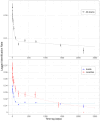Non-invasive methods characterise the world's largest tiger shark aggregation in Fuvahmulah, Maldives
- PMID: 39313535
- PMCID: PMC11420367
- DOI: 10.1038/s41598-024-73079-3
Non-invasive methods characterise the world's largest tiger shark aggregation in Fuvahmulah, Maldives
Abstract
Tiger sharks are apex predators with a circumglobal tropical and warm-temperate distribution, with a general lack of population data for the central Indian Ocean. In Fuvahmulah, Maldives, tiger sharks display frequent use of the harbour area, attracted by discarded fish waste. Here, we document the population structure, residency, and reproductive characteristics of the world's largest known tiger shark aggregation in a geographically-restricted area. Using non-invasive methods, photo identification and laser photogrammetry, we identified 239 individual tiger sharks over a 7-year study period. The aggregation was female-dominated (84.5%), with both large juveniles and adults present. Adult females were resighted over the entire study period displaying strong inter- and intra-annual site fidelity. Modelled residency using maximum likelihood methods suggests they spent 60.7 ± S.E. 7.5 days in Fuvahmulah, with a larger aggregation size, shorter residence periods and longer absence periods compared to juvenile females. Prolonged abdominal distensions of adult females indicate they likely stay near Fuvahmulah during gestation and reproduce biennially. Fuvahmulah seems to provide suitable conditions for gestation given the year-round provision of food and warm waters, exhibited by strong site fidelity and temporal residency. Our results show indications of a thriving population within the confines of protected waters.
Keywords: Gestation; LIR; Marine megafauna; Maximum-likelihood models; Photo ID; Site fidelity.
© 2024. The Author(s).
Conflict of interest statement
The authors declare no competing interests.
Figures





References
-
- Ripple, W. J. et al. Status and ecological effects of the world’s largest carnivores. Science343, 1241484 (2014). - PubMed
-
- Pacoureau, N. et al. Half a century of global decline in oceanic sharks and rays. Nature589, 567–571 (2021). - PubMed
-
- Dulvy, N. K. et al. Overfishing drives over one-third of all sharks and rays toward a global extinction crisis. Curr. Biol.31, 4773–4787e8 (2021). - PubMed
-
- Heithaus, M. R., Frid, A., Wirsing, A. J. & Worm, B. Predicting ecological consequences of marine top predator declines. Trends Ecol. Evol.23, 202–210 (2008). - PubMed
MeSH terms
LinkOut - more resources
Full Text Sources
Miscellaneous

